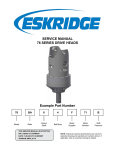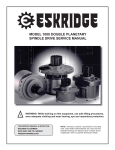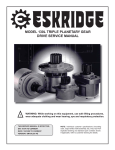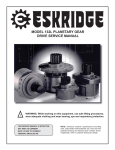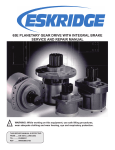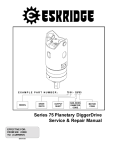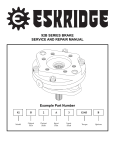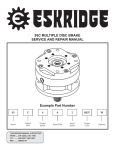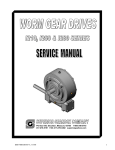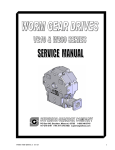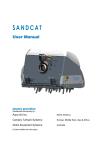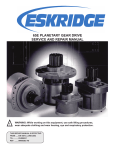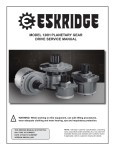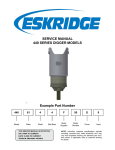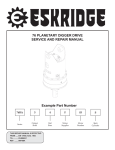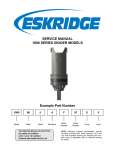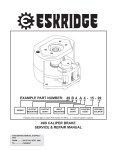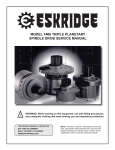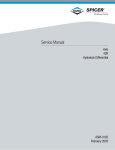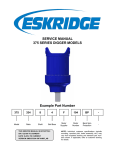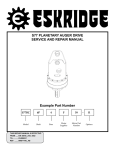Download model 34 planetary digger drive service manual
Transcript
MODEL 34 PLANETARY DIGGER DRIVE SERVICE MANUAL ! WARNING: While working on this equipment, use safe lifting procedures, wear adequate clothing and wear hearing, eye and respiratory protection. THIS SERVICE MANUAL IS EFFECTIVE: S/N: 46968 TO CURRENT DATE: 6/28/10 TO CURRENT VERSION:.SM34L-AA NOTE: Individual customer specifications (mounting case, output shaft, brake assembly, etc.) may vary from exploded drawing and standard part numbers shown. If applicable, refer to customer drawing for details. 25A 25G 40B 50 (40A) 25B 30C 25H 30B 40N 40L 40M 4 40H 45 40P 16C 14B 40G 40F 16D 40J 3 30A 12B 8C 8E 8D 40K 6B 25C 8F 8A 8B 8E 5C 7 14A 5A 6A 5E 5D 5F 5G 5D 16B 5B 5E 12A 40D 40E 20C 20D 30A 40C 16B 1 20B 20A 16A (2) Model 34 service manual, SM34L-AA Page 1 Eskridge, Inc. Olathe, Ks. 913-782-1238 www.eskridgeinc.com LUBRICATION & MAINTENANCE Using the chart below, determine an appropriate lubricant viscosity. Use only EP (extreme pressure) or API GL-5 designated lubricants. Change the lubricant after the first 50 hours of operation and at 500 hour intervals thereafter. The gear drive should be partially disassembled to inspect gears and bearings at 1000 hour intervals. Recommended ambient and operating temperatures for conventional and synthetic gear lubricants -50 -25 0 25 50 75 100 125 150 175 200 225 250 F 107 121 C 80W90 conventional 75W90 conventional 85W140 conventional Min Ambient/operating temp Max Operating temp Max Ambient temp 75W90 synthetic 80W140 synthetic -45 -32 -18 -4 10 24 38 52 66 79 93 Note: Ambient temperature is the air temperature measured in the immediate vicinity of the gearbox. A Gearbox exposed to the direct rays of the sun or other radiant heat sources will operate at higher temperatures and therefore must be given special consideration. The max operating temp must not be exceeded under any circumstances, regardless of ambient temperature. ESKRIDGE MODEL 34 OIL CAPACITY The oil capacity of this unit is 9.75 pints/(4.6 liters). Proper oil level will measure to middle of primary ring gear when auger drive is in vertical position. To check the oil in fully assembled units, fill the gear drive with the proper oil (see information above) until it runs out of the fill plug while the auger drive is leaning approximately 4.30 inches from vertical (approximately 7°); see the illustration to the right. Troubleshooting FILL PORT 4.30 Rattling, Grinding or Whining Noises Hydraulic motor failure and/or difficulties are commonly confused with gear drive problems, as they can share similar symptoms: reports of rattling, grinding or whining noises in the digger assembly. Carefully check the hydraulic motor for problems before removing the digger drive from the boom. If the digger drive is removed, a motor problem can only be determined by testing the motor on a hydraulic test stand or by eliminating the gear drive as the noise source after a total teardown of the unit. If you determine that the hydraulic motor is the source of the problem, please contact the original equipment manufacturer of the digger drive assembly. Shifting Difficulties/Jumping Out of Gear This symptom, commonly attributed to gear drive failure, can be due to air in the hydraulic lines leading to the drive, not the drive itself. Excessive back-pressure in the system may also cause this problem. Inability to Shift into High Gear This symptom can be due to a poorly adjusted shift cylinder. While the cylinder is carefully set at the factory, the process of disassembly may turn or move the cylinder in such a way that it contacts the case; contact between the cylinder body and the gear drive prevents the rod from making its full one inch travel. Difficult, Rough or Impossible Shifting Hand testing a shifter may indicate a “no shift” condition even when the shifter is okay. If metal-to-metal contact is made, a short turn of the output shaft may align shifter and allow shift to occur. Diagnosing the Upper Gear Drive Area The Series 34 digger drive cannot be shifted “on the fly.” The digger drive must be at a complete stop, with the load removed (backed out of hole in ground), before shifting. Shifting on the fly is the primary cause of damage to the gears in the shifter assembly. Damage caused by shifting on the fly will be seen as initial grinding of the gears at the gear faces, a wear pattern developing on the top of the cluster gears and on the shift gear itself, and a severe wear pattern developing on the points of the shifter gear. Additionally, the sun gear will show damage on the points: a rounding, or even severe burring, of these parts is possible. Model 34 service manual, SM34L-AA Page 2 Eskridge, Inc. Olathe, Ks. 913-782-1238 www.eskridgeinc.com Unit Teardown 1) Primary Carrier Assembly Teardown Items(8A, 8B, 8C, 8D, 8E and 8F) Scribe a line across the outside of the unit from the bail (40B) to the bearing carrier (1) before disassembly to aid in the proper positioning of pieces during reassembly. 2) Remove drain plugs (30A) and drain oil from unit. The oil will drain out more quickly and completely if warm. 3) Remove upper shift cylinder (40A) bolt. If shifter performance is in doubt, leave lower bolt in place and follow cylinder adjustment procedure (Step 14 in Unit Assembly Procedure) to see if poor cylinder adjustment could be the cause of “no-shift” or “partial-shift” condition. 8C 8E 8D 8F 8A 8B 8E Rotate planet gears (8B) to check for abnormal noise or roughness in bearings (8D). If further inspection or replacement is required, proceed as follows. 4) Remove lower shift cylinder (40A) bolt, nut and washer. The bolt and nut are accessible through the clearance hole in the bail. 5) Remove the twenty 7/16-20 cap-screws (25A) and lockwashers (25G) and lift the bail (40B) from the unit. 1) Drive roll pins (8F) completely into the planet shafts (8C). 2) Slide planet shafts (8C) out of carrier (8A). 6) Remove two cap-screws (25B) and lock washers (25H) from hydraulic motor (50). Notice that the motor is larger on one side: it must be replaced the same position as removed. Remove motor from unit. Check o-ring (16D) for damage. 3) Remove planet gears (8B), washers (8E) and bearings (8D) from carrier (8A). 4) Inspect the planet gear, planet shaft and bearings. Check for spalling, bruising or other damage and replace components as necessary. 5) Remove roll pins (8F) from planet shafts using a 3/16 inch pin punch. 7) 8) 9) Observe location of shift fork (40L), shifter gear assembly (Items 16C, 40F, 40G, 40H, 40J and 45) and top case (3). Check for binding or loose shift connections. Press down on shift lever (40F). Remove shifter gear assembly (Items 4, 40M and 40N). If shifter is jammed and sun gear (4) cannot be removed, dismantle shifter assembly in the case by removing snap rings (40G). Pull shifter shaft out (45) of case. Pull shifter collar assembly (40M), fork (40L) and shifter gear (4) out of case. Shifter gear should be free of nicks, burrs or gouges. Use a screwdriver, wood chisel or similar flat strong tool ground flat for insertion between the aluminum top case (3) and the ring gear (12A). Tap lightly on tool: do not drive into case, heavy prying will damage the o-ring contact surfaces in the case. Remove the top case assembly (Items 3, 6A, 6B, 12B, 14B, 25C, 30A, 40K and 40P). 10) Lift the primary planet carrier subassembly out of the unit (8). Primary Carrier Reassembly 1)Press two bearing assemblies (8D) into each cluster gear (8B). Place one washer on top and one washer on bottom of the cluster gear and install into carrier. 2) Planet shafts (8C) should be installed with chamfered end of 3/16 inch roll pin hole towards outside diameter of carrier (8A); this will ease alignment of holes while inserting roll pins. 3) Drive roll pin (8F) into the carrier hole and into planet shaft to retain parts. Repeat for remaining planet gears. 11) If sun gear (7) has not been removed from digger drive, do so now. (Sometimes the sun gear sticks to the primary carrier (8)). 12) Remove secondary ring gear (12A). Inspect top-case to gear and gear to base O-ring (16B); discard if damaged or deformed. 13) Lift the secondary planet carrier subassembly out of the unit (5). The unit is now disassembled into groups of parts. The area(s) requiring repair should be identified by thorough inspection of the individual components after they have been cleaned and dried. Model 34 service manual, SM34L-AA Page 3 Eskridge, Inc. Olathe, Ks. 913-782-1238 www.eskridgeinc.com Secondary Carrier Assembly Teardown Bearing Carrier Subassembly Teardown Items(5A, 5B, 5C, 5D, 5E, 5F and 5G) Items(1, 2, 16A, 16B, 20A, 20B, 20C, 20D, 30A, 40C, 40D and 40E) 5C 5A 5F 5E 40D 5D 40E 5G 20C 5D 20D 5B 30A 5E 40C 16B 1 20B 20A 16A Rotate planet gears (5B) to check for abnormal noise or roughness in bearings (5D). If further inspection or replacement is required, proceed as follows. 1) Drive roll pins (5F) completely into the planet shafts (5C). 2) Slide planet shafts (5C) out of carrier (5A). 3) Remove planet gears (5B), washers (5E) and bearings (5D) from carrier (5A). 4) Inspect the planet gear, planet shaft and bearings. Check for spalling, bruising or other damage and replace components as necessary. Note: When using loose (uncaged individual) rollers, all rollers in the planet gear should be replaced if any are found to be defective 5) Remove roll pins (5F) from planet shafts using a 3/16 inch pin punch. (2) 1) Remove the lock ring (40D) using a heel bar or puller; if using a heel bar, be sure not to pry against the cage of the inner output shaft bearing (20C). Remove the split ring segments (40E) and shims (40C). Caution: Since the shaft is no longer positively retained, care should be taken to avoid personal injury. Care should also be taken not to damage it while pressing through base. Note: Removing the shaft from the base assembly damages the shaft seal and the seal will need to be replaced. 2) Place bearing carrier (1) external side down, on a plate or table. Press output shaft out bottom of base by applying a load to internal end of shaft until it passes through inner shaft bearing cone (20C). 3) A gear puller may be used to remove the outer bearing cone (20A) from the shaft (2). If reusing old bearing cone, do not pull on or damage roller cage. Remove the shaft seal (16A) for inspection or replacement. 4) Inspect inner and outer bearing cups (20B & 20D). If cups are damaged, drive them out using a brass drift and utilizing the bearing knock-out notches in the base (1) Secondary Carrier Reassembly 1) Loose roller installation: a) Set planet washer (5E) on work table with planet gear (5B) on top of it. Center planet washer to planet gear as closely as possible. 2) 3) b) Center planet shaft (5C) in planet gear (5B) bearing bore. c) Begin placing rollers (5D) around shaft (5C). There should be clearance for last roller to slide in. Install spacer (5G) then install second row of rollers. d) Place a washer (5E) over gear (5B) and shaft (5C). e) Carefully slide assembly off of table, holding planet washers (5E) against planet gear (5B). 1) Clean all foreign material from the magnetic oil plug (30A) located on bearing carrier (1). f) Slide planet shaft (5C) out of the assembly and slide assembly into carrier. 2) Place bearing carrier (1) exterior side up on work table. 3) Apply a layer of lithium or general purpose bearing grease to the roller contact surface of outer bearing cup (20B). 4) Press outer bearing cone (20A) onto the shaft until it seats against the shoulder. 5) Place the shaft (2) with the bearing (20A) into the base (1). Planet shafts (5C) should be installed with chamfered end of 3/16 inch roll pin hole towards outside diameter of carrier (5A); this will ease alignment of holes while inserting roll pins (5F). Drive roll pin (5F) into the carrier hole and into planet shaft to retain parts. Repeat for remaining planet gears. Bearing Carrier Reassembly Model 34 service manual, SM34L-AA Page 4 Eskridge, Inc. Olathe, Ks. 913-782-1238 www.eskridgeinc.com 6) 7) 8) Flip shaft/bearing carrier assembly, and apply lithium or general purpose bearing grease to roller contact surface of the inner cup (20D). Then press inner bearing cone (20C) onto shaft (2) until it seats against inner bearing cup (20D). Prior to installation of the shaft seal (16A), the preload may result in a rolling torque which varies between 100 to 300 in-lb. The bearing preload should be tailored to your application; a low-speed application may require a high pre-load, while highspeed applications usually benefit from low pre-load. Adding shims (40C) will increase the pre-load on the bearing set. Determine your pre-load requirement and install shims to obtain this pre-load. Install the Load-N-Lock™ segments (40E) over the shims (40C) and into the groove in the shaft (2). The Load-N-Lock segments should be oriented so the 15 degree angle matches the 15 degree angle groove cut in the shaft and the small detent on the OD of the segments is oriented towards the bearings. Finally, install the lock ring (40D) over the segments (40E). The Load-N-Lock lock ring must be oriented so the smaller outside diameter is oriented towards the bearings; the detent groove in the lock ring (which matches the detent bead in the Load-NLock segments) should be towards the bearings as well. Top Case Assembly Teardown Items(3, 4, 6A, 6B, 12B, 14B, 16C, 16D, 25C, 30A, 40F, 40H, 40J, 40K, 40L, 40M, 40N 40P and 45) 40N 40L 40M 4 40H 40F 45 1) Install primary ring gear (12B) into top case (3). 2) Prior to inserting socket-head cap-screws, coat the internal threads of the top case with Loctite 242 thread-locking compound or equivalent. Tighten cap-screws to a torque of 30 ft-lb. 3) Install the sun gear (6A) and lightly coat the bushing with grease. 4) Install the thrust washer (14B) and retaining ring (40P). 5) Lubricate shifter shaft (45) and O-ring (16C) with grease when reassembling. Insert the shifter shaft assembly (16C, 40F, 40H, 40J and 45) into case (3) and shifter fork (40L) then retain with E-ring (40G) 1) To disassemble shifter gear assembly (4, 40M and 40N), remove retaining ring (40N) and pull pieces apart. 2) Check for worn parts; replace as necessary. Reassembly 1) 14B 40G All subassembly service or repairs should be complete at this time. Continue to Unit Assembly to complete unit buildup. Unit Reassembly 1) Install the secondary carrier assembly onto the output shaft; align the splines of the carrier (5A) with the output shaft (2) splines and slide the carrier onto the shaft. 2) Lubricate o-ring(s) (16B) and install on the ring gear (12A) pilot. 16D 40J 3 30A 12B 40K 6B 25C 6A 1) Inspect primary ring gear (12B) for abnormal wear or damaged teeth. If replacement is required, remove twelve socket head cap-screws (25C) from ring gear and remove. 2) To remove sun gear (6A), first remove retaining ring (40P) and thrust washer (14B). 3) To disassemble shift lever and fork, remove E-type retaining ring (40G) on inside, then slide apart. 4) Inspect o-ring (16C) on shifter shaft (45) for damage. Lubricate shaft with grease when reassembling. 5) Clean and inspect all remaining parts (bushings in the top case and sun gear, for example) and replace any that are worn or damaged. Reassemble in reverse order. Note: If the shift cylinder assembly (40A) is damaged, it must be replaced as a unit. Eskridge does not sell repair kits for the shift cylinders. Damaged fittings or rod-ends may be replaced, if necessary. 40P 16C Shifter Gear Assembly Teardown Caution: Hold ring gear(s) by outside diameter or use lifting device to prevent injury. 3) Align gear teeth of secondary ring gear the gear teeth of the planet gears (5B) on base, then align mounting holes of with holes in base. Use the scribed during disassembly for reference. 4) (12A) with and place ring gear line made Install the secondary sun gear (7) into the secondary carrier assembly (5) and then install primary carrier assembly (8). A special tool should be made for the timing process. An old shifter gear, cut off above the lower gear and welded to a 6” long bolt, works well. If an extra shifter gear is not available, the timing will be more difficult; the timing tool keeps gears in time as Top Case Reassembly Model 34 service manual, SM34L-AA Page 5 Eskridge, Inc. Olathe, Ks. 913-782-1238 www.eskridgeinc.com they mesh with primary ring gear (12B) (mounted in top case (3)). 5) Timing procedure: The diagram below shows the orientation of the cluster gears (8B) for correct timing. There are machinist’s marks on each of the three cluster gears (8B). These marks should be aligned so that each points toward the center of the primary planet carrier. Use the of the timing tools mentioned above will make top case installation easier. Leave the timing tool in the center of the cluster gears and use it to rotate them until top case is properly installed. 6) Install o-ring (16B) onto top case (3). While keeping the timing marks aligned, position the top case near the proper orientation to scribed line on outside of unit. Work top case down until fully seated with gears in time. CAUTION: If unit is not properly timed, the gear drive will be severely damaged. Be sure gear drive turns smoothly and easily. 7) Install shifter gear assembly (4, 40M and 40N) by pushing down on the shift lever (40F) to allow clearance. 8) Fill unit with EP 80/90 gear oil to proper level as specified on Page 3. 9) Install o-ring (16D) onto hydraulic motor (50). 10) Using hand tools to avoid stripping the aluminum, install hydraulic motor on mounting pad on top case (3) with two capscrews (25B) and lockwashers (25H); torque to 130 ft-lbs. 11) Bolt lower end of shift cylinder assembly (40A) to shift lever (40F), torque the jam nut to 20 ft-lbs. 12) Line up scribe mark on bail assembly (40B) with scribe mark on top case (3) and lower bail over hydraulic motor (50) until bail flange contacts the cover. 13) Check all o-rings to make sure they are properly seated. Install twenty cap-screws (25A) and lockwashers (25G) and tighten to 80 ft-lb dry, 60 ft-lb if the fasteners are lubricated. 14) Install and adjust shift cylinder: Shifter cylinder should be compressed to its shortest length. Next, with the shifter gear pushed all the way up (towards the motor), adjust the length of the shifter cylinder to allow installation onto the bail; tighten jam nuts and torque bolt to 20 ft-lbs. Verify smooth and complete shift operation. The gearbox is not ready to use. Model 34 service manual, SM34L-AA Page 6 Eskridge, Inc. Olathe, Ks. 913-782-1238 www.eskridgeinc.com







